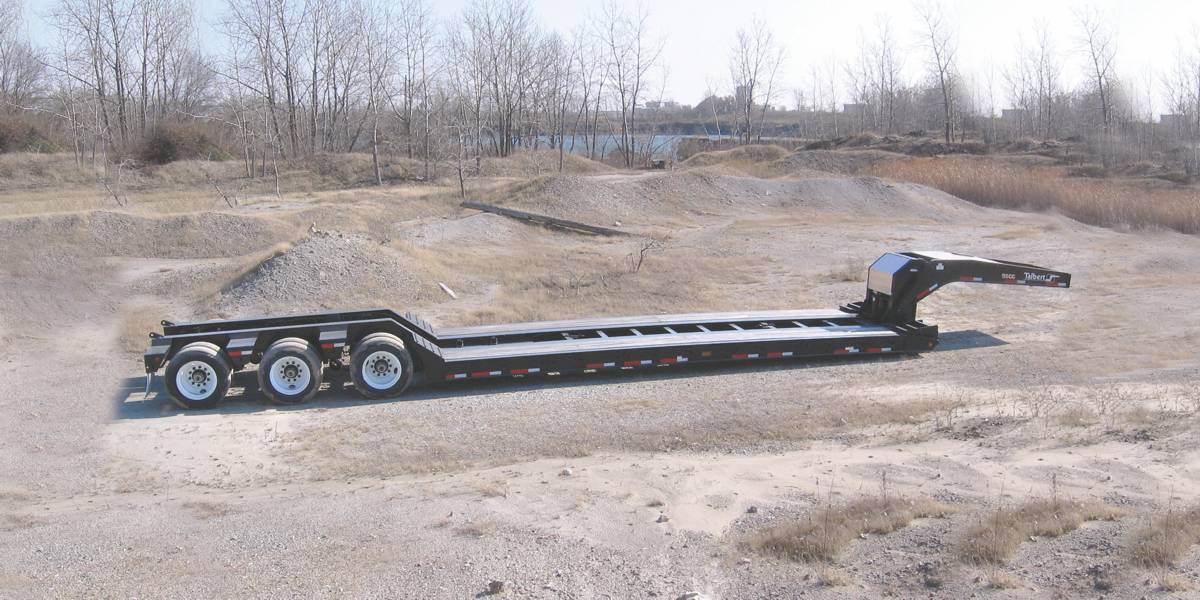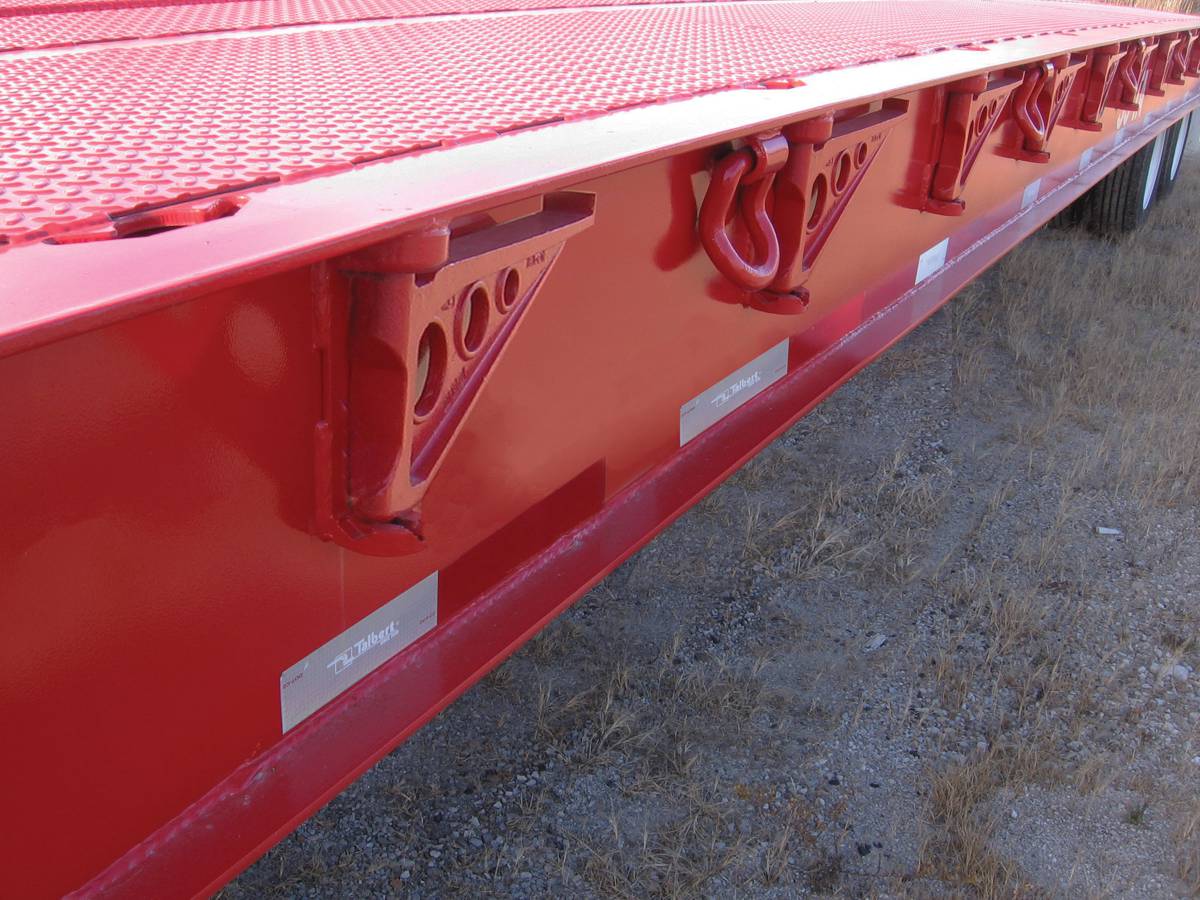Talbert Manufacturing explores Trailer Total Cost of Ownership
With a cost on par with the average U.S. home mortgage, heavy-haul trailers represent a significant investment for businesses. The right trailer can provide fast ROI, greater productivity and increased profits. The wrong decision, however, can leave trucking companies with the financial burden of a unit that will cost far more in the long run than the business is prepared to take on.
Unfortunately, the second scenario is all too common due to an incomplete understanding of total cost of ownership. Purchase price is sometimes the only factor buyers consider when evaluating the cost of a heavy-haul trailer.
The initial cost, however, can be misleading when considered alone. A comprehensive approach to calculating total cost of ownership requires an understanding of multiple factors, many of which cannot be found on the price tag.

1. Purchase Price
The first and most obvious element of total cost of ownership is purchase price. To the seasoned equipment buyer, price is evaluated based on what the equipment needs to do and the value it adds to the business. Minimizing upfront costs isn’t as important to total cost of ownership as purchasing a trailer that efficiently handles the hauls ahead of it. There are a few things fleet owners can look at to help determine the best trailer for their needs and minimize long-term expenses.
Capacity
Fleet owners must be sure the heavy-haul trailer they invest in can stand up to expected load capacities. And as experienced fleet managers know, weight capacity ratings only tell part of the story.
The overall weight a trailer can handle is just that, whether a 35- or 50-ton lowbed. However, there is a bit more to consider. Load concentration — or the length of the deck that can handle the weight — varies from one manufacturer to the next. For example, three manufacturers each offer a 26-foot lowbed that can haul 50 tons, but one may need the entire deck length to safely carry the weight, while another is rated for 50 tons in a 16-foot span, and another the same weight at half the deck length. Be sure to understand the difference in ratings. Loads are rarely evenly distributed across the entire deck, so understanding concentrated load ratings for a particular trailer ensures operators are not overloading the trailer — decreasing safety and efficiency and racking up unnecessary maintenance costs.
Axle Configurations
Laws and regulations vary from state to state, so it’s important to choose a trailer that maximizes the load in each state to minimize permit costs. Work with a manufacturer that understands this and will provide the best possible weight distribution over the axles. This can include adding a fourth flip axle or spreading two or three additional axles apart to evenly accept the load. Choosing axle configurations that offers more flexibility to handle different types of loads increases earning potential over the lifetime of the trailer.
Furthermore, manufacturers often interpret Gross Vehicle Weight Rating (GVWR) and Gross Axle Weight Rating (GAWR) differently. Misunderstandings could lead to limited ratings and configurations, which could affect all that is needed to get the job done.
Engineering & Safety Rating
Well-thought-out features and designs are a good indication of experienced engineering at work. This goes beyond steel, welding and bolts. Good engineering is about understanding each customer’s needs and building a trailer optimized for durability, longevity and minimal maintenance. Working with a manufacturer that can provide custom-built solutions is ideal. They can design a trailer that can handle the load, which minimizes maintenance and ensures owners get the greatest longevity.
The trailer’s safety rating is one of the quickest ways to determine if a manufacturer uses high-quality components — such as heavy-duty T-1 steel and Apitong flooring — that will stand up to the jobs you have planned. The safety rating is intended to show operators how well the trailer is equipped to deal with the extra stress that comes from things like bumps, chuckholes and railroad tracks as it travels down the road.
These bumps in the road cause the trailer to experience a momentary magnification of payload. In general, trailers can expect an average magnification of payload ratio 1.8 to 1. This means a 50-ton-rated trailer with a 50-ton load will experience 1.8 times the stress, or 90 tons, as it travels over inconsistencies in the road.
Safety ratings tell the end user how much magnification of payload the trailer is designed to withstand. Safety ratings will range from no margin to up to 2.5 to 1, an industry high. A trailer with a high safety rating and built with high-quality materials may cost more up front but will better stand up to the day-to-day stresses of hauling loads. Drivers should keep in mind that though the average magnification of payload is 1.8, in many instances the trailer will experience much more than that. A trailer designed with extra margin in the safety rating will experience less stress, wear and damage, resulting in reduced maintenance costs over time.
Heavy-haul trailers built with lower-quality materials offer a lower safety rating so they simply can’t provide that kind of longevity. As a result, the trailers are more prone to premature damage and require more maintenance, resulting in less time working and a lower return over the life of the trailer.

2. Maintenance
The ease and cost of maintenance contribute greatly to the lifetime cost of ownership of heavy-haul trailers. A well-designed trailer will provide long maintenance intervals and be easy to work on when maintenance is necessary. A good manufacturer will also focus on ensuring wear parts are readily available at a reasonable cost.
Long Maintenance Intervals
Some of the most critical elements of a maintenance-friendly trailer are the quality of the removable gooseneck, suspension system and components like steel and paint.
Removable Gooseneck: The removable gooseneck revolutionized heavy haul, increasing safety and productivity on jobsites around the world. Since then, improvements such as hydraulics have further increased overall efficiency. In addition to profile and liftability, ease of use should be considered when selecting a removable gooseneck for optimum ROI. Industry-leading manufacturers offer hydraulic removable gooseneck systems that operate at 5 to 15 gpm, making them less susceptible to leaks. These low-pressure systems also use hoses that are readily available and more cost efficient than those needed for high-pressure systems. The location of the hydraulic system on the gooseneck can further increase ease of maintenance. Mounting the system within the gooseneck base section limits vibration and damage, increasing the length of maintenance intervals.
Suspension Systems: All things being equal, a trailer with a properly spec’d suspension system experiences less wear and tear. A maintenance-friendly suspension system offers features designed specifically to increase its resilience and lifespan, as well as simplify the maintenance process when things do break down. Two easy things to look for are clamp-in bushings and contoured axle seats.
Solid clamp-in bushings offer an extended life over slotted designs and easy replacement that doesn’t require an expensive press. The ease of replacement eliminates the need to haul the trailer to a commercial shop and greatly reduces the cost.
Extra-long, contoured axle seats are another indicator of a low-maintenance suspension system. Engineering axle seats with a contour in the middle reduces stress on the weld, reducing the likelihood of costly breaks. The extra length and contour design also provide a strong connection without the need of added U-bolts, reducing the total weight of the system and the added maintenance costs that go with it.
Steel & Paint: Fleet owners should keep wear components in mind when deciding which unit will best meet the needs of their operation. High-quality materials and finishes will last longer than traditional paints and lower-cost alternatives, a critical boost in longevity for fleet managers that need their trailers to stand up to challenging conditions.
For must-hold-up situations, choose a trailer built with high-strength steel, such as 12-inch-deep I-beams with a minimum yield strength of 100,000 psi. This, along with premium primer and topcoat finishes, will ensure long-term durability.
Ease of Maintenance
Some manufacturers design their trailers with maintenance points that are fast and easy to access, which is important for minimizing the time and money spent maintaining the unit. For example, cylinders that are mounted parallel to the ground allow technicians to simply remove four bolts and unpin the cylinder for replacement. This takes a matter of minutes, compared to as many as eight hours replacing vertically mounted cylinders.
Cylinder replacement varies based on road conditions, load distribution and other factors unique to each trailer and operator. In general, replacing parallel cylinders saves a significant amount of time and effort over the life of the trailer. Even if required cylinder replacement is minimal, over the lifetime of a trailer it demonstrates how ease of maintenance proves itself as a vital variable in the total cost of ownership formula.

3. Resale Value
The last thing to keep in mind when considering how much a trailer will cost over its lifetime is how much money it’ll be worth when it comes time to sell. At the time of resale, the decision to buy a trailer with high-quality components really pays off. Often, to know the true quality of a trailer, you can look at the value at auction.
In conjunction with a proactive preventative maintenance program, a high-quality trailer from a reputable manufacturer may provide over 30 years of useful life. This longevity results in sought-after resale units that fetch a higher price at auction than lower-quality trailers that are showing their age. It should be considered as part of a comprehensive evaluation of total cost of ownership.
Conclusion
The number on the price tag is important, but it only takes you so far. Heavy-haul trailers travel thousands of miles over their lifetimes — and a lot can happen between A and B. To truly understand total cost of ownership, business owners and operators must have a comprehensive understanding of what their trailer will cost in its lifetime.
Considering these post-purchase costs before making a decision will help ensure trailer lifetime costs do not undermine any savings that were enjoyed at the moment of purchase. A well-researched trailer investment can provide fast ROI and reliability that goes on for miles.

Talbert Manufacturing
Talbert has been building world-class heavy-haul and specialized trailers to rigorous customer specifications since 1938. The company offers complete lines of heavy-haul trailers and specialized transportation equipment for the commercial, industrial, military and government sectors.
Its trailers and equipment are used in applications as diverse as renewable energy, aerospace, heavy construction, in-plant material handling, manufacturing and processing systems and much more.

Troy Geisler
Article By Troy Geisler, vice president of sales and marketing, Talbert Manufacturing. Troy is the vice president of sales and marketing for Talbert Manufacturing. He has more than 15 years of experience in the trailer industry, including 10 years with Talbert. Troy earned his bachelor’s degree from Purdue University in West Lafayette, Indiana.




















